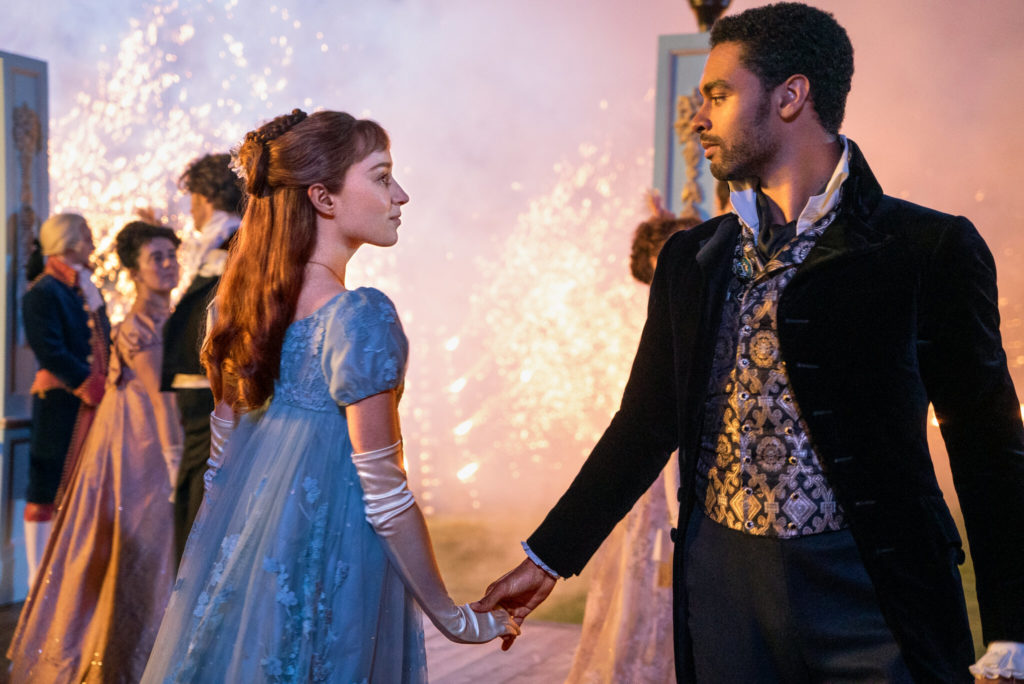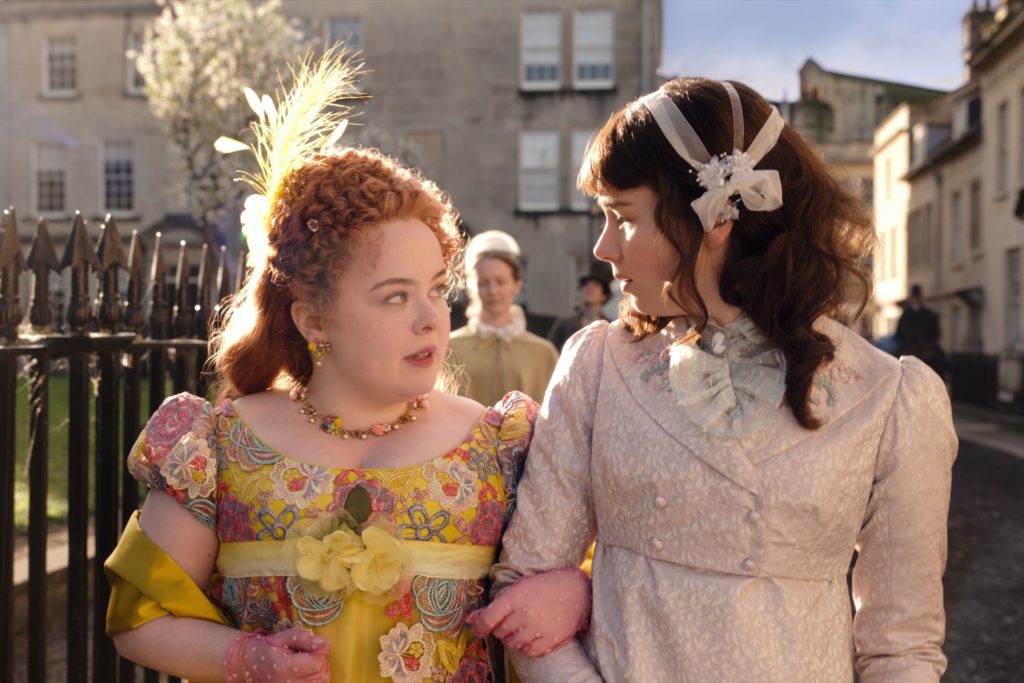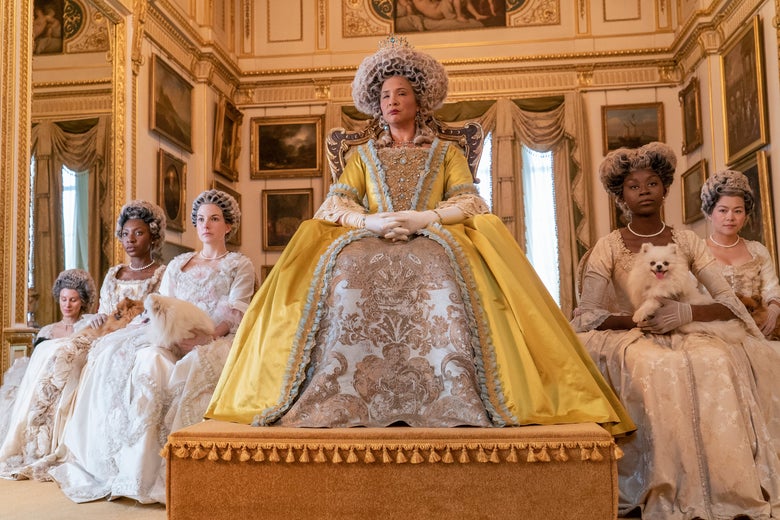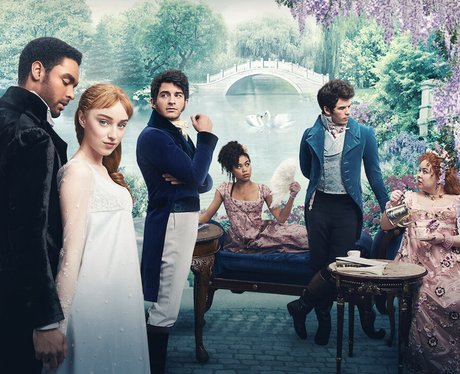Shonda Rhimes’s popular period piece takes on a feminist and racially progressive experiment
by Kaylah Staknis
Bridgerton has been one of Netflix’s most popular series. Produced by Shonda Rhimes, it reinvents the classic period romance so beloved in cinematic adaptations of novels such as Pride and Prejudice and Jane Eyre. Bridgerton delves into early nineteenth-century England but adds striking modern elements. The series features elements typical of period pieces, including a woman coming of age, a quest for love central to the plot, and tantalizingly flirtatious dialogue. The series follows the eldest daughter of the powerful Bridgerton family, Daphne (Phoebe Dynevor) as she makes her debut on London’s competitive marriage market. Daphne quickly becomes acquainted with the Duke of Hastings Simon Bassett (Rene-Jean Page), played by an actor of Zimbabwean descent to portray a historical fantasy of black royalty. The two feign to be courting to entice other marriage suitors for Daphne, although plans and feelings change through promenades and scandals. What stands out in Bridgerton is the strong injection of liberal politics, training a feminist and racially colorblind lens on the Regency Era.

Critics hailed Daphne as a “feminist icon,” but Bridgerton actually sports an uncreative list of woes about the mistreatment of the fair sex with double standards and disconcerting dehumanization of black women. The soundtrack is caught up in this predicament. Classical covers of modern songs—stripped of their lyrics and scored for period ensembles— underscore the more momentous scenes of the series, and their unspoken commentary reinforces the falsely progressive angle. Let’s look at some examples.
Daphne’s potential for female agency remains unrealized, rather sporting like a tease. At first, her dreams of being a wife and mother seem to fit the traditional Cult of True Womanhood in which nineteenth-century women’s sphere was limited to the home and family, the antithesis of feminism. She then, however, fights for power over her future. She pleads with her overbearing brother for power to choose her own love match to marry. She holds forth asserting her intelligence and independence to her pretend lover Simon. What falls short is that she asserts little independent agency outside of her words. Through schemes, Daphne relies on Simon to rescue her from her older brother’s demands and ill marriage prospects. Bridgerton’s supposed feminist icon does not really practice what she’s preaching.
The soundtrack also hits the wrong note on modern feminism. Audiences recognize the classical covers of modern pop songs, whose familiar melodies are to remind viewers of the lyrics, meaning, and well-known singers. These details become increasingly important when they diminish female agency and reinforce the stereotypes on-screen.
Fifty-four minutes into episode two, Daphne asserts to Simon the importance of their scheme for her future. She insists she will not allow him to let her down. During her expression of agency, a string quartet plays a classical cover of the Shawn Mendes song “In My Blood.” Soundtrack composer Kris Bowers chose a song by a male artist to accompany Daphne’s powerful scene. “In My Blood,” is a song about heartbreak, with the chorus repeating “I need somebody now.” Viewers thus understand that she needs Simon and cannot ensure her future without the help of men.
The soundtrack diminishes Daphne a second time. Five minutes into episode three, Daphne manages to attract a plethora of attractive marriage suitors in the ballroom. Behind the scene, a string quartet’s cover of “bad guy” by Billie Eilish undermines her scene of feminine power. Eilish’s “bad guy” is a well-known satirical song with lyrics such as “make your mama sad” in which the narrator comically compares herself to the emotionally destructive men she falls in love with. Essentially, it is a self-deprecating song about being stupid in love. Thus, as Daphne finally gains influence and choice for her future, the soundtrack suggests she will use this power foolishly.
Eloise Bridgerton (Claudia Jessie) and Penelope Featherington (Nicola Coughlan) are intended to embody modern feminism. Both young women, uninterested in being debutantes, are more focused on books and their desires to attend university. From the first scene of episode one, when Eloise complains about her dress and impolitely screams to her sister Daphne, it is clear that she was written to fit the masculinized, asexual feminist typical in pop culture. Her character fosters the false idea that a woman cannot be feminine and powerful. Penelope’s character only reinforces this idea: she is overweight and wears little makeup in comparison to the other debutantes, and therefore, not surprisingly, ignored and maltreated for her appearance. The writers of Bridgerton present two potentially strong young women as stereotypes of the not traditionally beautiful, ungraceful feminists.

Likewise, Queen Charlotte does not come across as an early revolutionary. Aside from the short scenes of her reading Lady Whistledown’s gossip column, the Queen is used very little in the plot. The only powerful woman in the series, she’s shown enjoying luxurious baths, taking tea and using drugs. Truly, Her Majesty would have been a busy woman managing the Ton in London and running the country as her husband King George’s madness debilitated him. In true history, the Queen was a botanist, founded orphanages and held guardianship over her many children and insane husband. Bridgerton fails to do this early feminist justice through her small, near insulting role in the series.

The biggest insult by the writers of Bridgerton falls on black women. Similar to Eloise and Penelope, Marina Thompson (Ruby Barker) and Lady Danbury (Andjoa Andoh) are written as tropes. The only representative of black women’s courting experience in the series, Marina follows the Jezebel trope of a hypersexualized young black woman. Marina arrives at the Featherington house pregnant out of wedlock and with knowledge about sex that stands in stark contrast to the clueless innocence of the white debutantes. Behind the scene halfway through episode one in which many suitors arrive at the Featherington house for Marina after her first ball, a classical cover of “Girls Like You” by Maroon 5 plays. This familiar radio song emphasizes the Jezebel trope as audiences are reminded of its promiscuous lyrics “girls like you run ’round with guys like me / ‘Til sundown when I come through.”
Similarly, Lady Danbury follows the Mammy trope, although less conspicuously. She is presented as a maternal figure to Simon. She lacks depth, with no desires or connections outside of her servitude to facilitate Simon’s connection to Daphne. Lady Danbury is desexualized as a matronly figure. She is like a faithful worker to the Ton by simply throwing balls and facilitating marriages. The two principal black women in the series follow clearly dehumanizing and anti-feminist stereotypes. This goes beyond failing modern themes, but rather falls into the traditional problems of women portrayed in pop culture.
While Bridgerton has all the pleasantries of adored period pieces, its experiment in modern themes appears like an unsavory underbelly. Portraying a genre loved by young women, it has great potential to encourage defiance of the status quo. How could its black feminist producer fail her audience? Perhaps Shonda Rhimes intends a satire in Bridgerton. Rhimes seizes female stereotypes to undermine them. The soundtrack is an ironic commentary beneath the female caricatures waltzing around the ballrooms. The series is a diagnostic of the current conditions of women. Rhimes stays two steps ahead of feminism.
